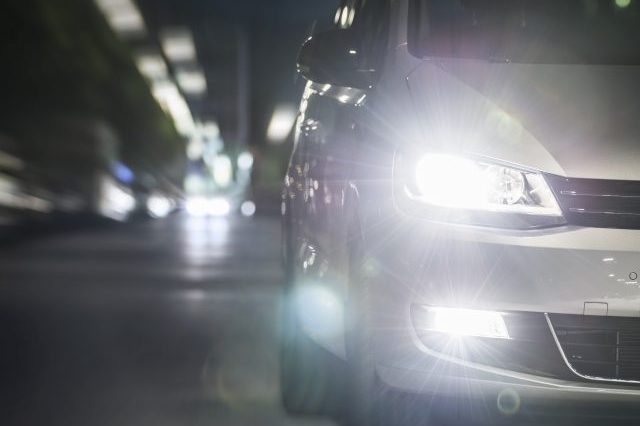Drivers are increasingly complaining about the intense LED headlight glare that comes from newer vehicles, but the issue is not as clear as one might think.
The U.S. is taking baby steps toward smart headlight systems that adjust their beams based on what is in their path and look less harsh to oncoming drivers, but they still could be years away from hitting the roads.
Why Are Headlights So Bright These Days?
Some experts say several factors are contributing to drivers reporting glare. One is that LED lights are not brighter, but the blueish-white light emitted is more irritating to the human eye. The others relate to the position of the headlights, the height of newer vehicles and older drivers.
AAA has published numerous studies about headlights and related issues such as glare and did not find a problem, according to Greg Brannon, director of automotive engineering and industry relations for AAA Inc. “LEDs put more light on roads where people need it,” he said. “There is no evidence that LED lights are a hazard.”
Drivers Disagree
Still, drivers are reporting discomfort and being blinded by oncoming cars with LED headlights and some are calling for them to be banned.
“There is a problem,” acknowledged Dr. John Bullough, director of the Light and Health Research Center at the Icahn School of Medicine at Mount Sinai in New York City. “There are some issues (with headlights) people are experiencing more than they did 10-to-20 years ago, and they are making more people complain. But the basic regulations for headlights and how they produce light in certain directions have been the same for several decades. Technology has changed.”
Over the past 10 years, automakers transitioned to LEDs and high-intensity discharge (HID) headlights from halogen headlights, which produce soft yellow light, which is easier on the eyes. On the plus side, LED bulbs last longer and an LED array has many small bulbs, which can be shifted in different directions to shape the beam. The white light also makes it easier to spot road markings and more closely resembles daylight.
But there are drawbacks. “They tend to make glare more noticeable and uncomfortable,” according to Bullough.

Calls to Regulate LED Headlights
Groups such as the Soft Lights Foundation argue that the use of LED and HID headlights “has become a source of dangerous, blinding glare,” and has an online petition asking Congress and federal agencies to regulate LEDs. More than 50,000 people have signed the petition so far.
Other factors are contributing to people experiencing headlight glare, according to Bullough. Many vehicles are higher now, so lights on SUVs and trucks shine directly into the eyes of sedan drivers, he said. “Passenger cars get a brighter splash of light.”
Also, headlights are often misaligned, and drivers don’t realize it. “Consistently, over a few decades, a lot of cars have poorly misdirected headlights,” said Bullough. “If they are too high, the beam hits (oncoming drivers) in the eyes. If they are too low, drivers can’t see much past their car.” Not all states require headlight alignment to be assessed, he added.
The aging of the U.S. population also plays a role, Brannon maintained. There were almost 48 million licensed drivers ages 65 and older in 2020, according to the latest research from the Centers for Disease Control and Prevention. That is a 68% increase over 20 years ago. “New technology looks different coming toward older drivers, when they are used to seeing a soft yellow glow,” he said. “The LED and HID lights draw drivers’ attention, and then they have a problem with a glare.”
People’s ability to see in the dark decreases every year after age 40, Brannon added, and drivers are less able to recover from glare. To cope with glare, Brannon recommended drivers modify their gaze and look at the road, not the oncoming headlights.
Smarter Headlights Are on the Way
If anything, headlights on U.S. cars should be brighter, Brannon said. The U.S. has a much lower maximum output for high beams than most countries and standards have not changed in decades. AAA research shows that 64% of American drivers do not extensively use their high beams, often out of concern for other drivers. But driving with low beams all the time can be a safety hazard. “If you are driving with low beams over 35 mph and encounter something in the road, you can’t stop in time,” according to Bullough.
Changes are coming, although slowly. More new cars in the U.S. have automatic high/low beam switching systems, which allow drivers to use their high beams all the time, because the headlights switch to low beams if they detect an oncoming vehicle.
Even more advanced technology is available, but not in the U.S., and although high-tech headlights have been approved here, it still could be years before drivers actually see them. Since 2013, Europe and most of the world have been using adaptive driving beam (ADB) headlights, which produce more light and automatically change the direction of the beam to reduce glare for oncoming drivers or pedestrians while not losing forward illumination.
Despite urging from multiple organizations, including AAA, the type of ADBs used by most of the world have not been approved for use in the U.S.
Crafting New ADBs
In 2022, the National Highway Traffic Safety Administration (NHTSA) approved ADB headlighting systems similar to what is used in other countries, but with different criteria for performance, according to Bullough.
The U.S. Department of Transportation drew up glare-proof specifications for ADB headlights, but more testing and information are required. Vehicle manufacturers are waiting for detailed specifications before starting to build and install these systems, to avoid misinterpretations and recalls, according to Bullough.
Because these headlights will be brighter, the changes also will require some adjustments by drivers, but the headlights are overdue, said Brannon. “Modern headlight systems put light where you need it,” he said. “Over time, people will become more accustomed to it.”
Need headlight maintenance? Visit your nearest AAA Approved Auto Repair Facility. Members can save up to $75 per visit – that pays for your membership! Search for AAR facilities.
How do you feel about headlight glare? Share your thoughts in the comments below.
218 Thoughts on “What’s the Story With Headlight Glare?”
Leave A Comment
Comments are subject to moderation and may or may not be published at the editor’s discretion. Only comments that are relevant to the article and add value to the Your AAA community will be considered. Comments may be edited for clarity and length.
















I have seen the change in head lights and agree with the issue. As far as age being an issue not true many younger people I have spoke with under the age of 30 have actually had to stop, due to being blinded on the county roads where I live. What makes it worse is the fact that there are no divided lane lines at all. I believe it is just another way of controlling . As I have read many articles it is working. People mention ” I no longer drive at night and stay home” its working. Me when I encounter this I just put on my high beams, the opposing car flicks his lights on and off at me, I just leave them on. May be this will make the owner change the lights if they get enough of this action happening. Or they won’t drive at night.
Years ago my Driver’s Ed Instructor told the class that when you use your high beams in response to another driver’s use of theirs then you have two idiots that cannot see doubling the chance of collision. A more adaptive approach is to wear blue light blocking glasses at night.
Hi Ken, Something to consider. Some people don’t think about headlight glare when purchasing a new vehicle. In todays day and age, I am sure many people “can’t” afford to fix/replace LED headlights. You putting on your high beams could cause them to crash from your glare, How would you feel knowing you caused someone/family to crash due to the glare from your hi beams? It’s the manufacturers that need to know or come up with a solution. I thought perhaps a “glare reducing windshield”? or Insurance companies could give out “glare reducing glasses”, both options much cheaper that replacing or coming up with a new design of headlights for car makers and buyers.
I find this article disappointing. I appreciate that you are covering this important topic; but the article sounds, ironically, like gaslighting of all of us who are really struggling with these extremely bright headlights. In addition to all these comments, I have read about this issue, and despite your study showing it’s ‘not a problem,’ there are plenty of studies showing otherwise. I know many people who refuse to drive after dark now simply because of this issue. Some people get yelled at for using high beams when they aren’t even using them, because of this issue. AAA, you are meant to be here for drivers first and foremost. Your article should have supported our concerns and lived experiences more than this article showed.
When driving at night, newer headlights cause so much glare, I can’t see the road. My eyes are fine, I have them tested once a year and I’ve discussed night vision with my Doctors. Another factor is that the painted lines on highways in the northeast are so deteriorated that they are hard to see. I don’t know whether the paint fails more quickly or the highway departments are not repainting quickly enough. Driving on unfamiliar roads at night are truly treacherous.
These LED lights should be banned, and those already in use should have a lens modifier installed. These LED advocates have obviously never driven on winding, hilly, rainy, roads. Numerous times I have had to stop my car because I was temporarily blinded!
I are there liabilities to someone who pit aftermarket LED and causes oncoming traffic to cradh
The lights are awful, I had cataract surgery and hoped that would help. I did find an online place for glasses, priced as they should be. Just get your eye doc to write up your prescription, enter it in when prompted, pick out what you like. There is almost no reason to be blinded while you are driving.
Passenger cars are not to bad because the lights are lower. It’s the Monster trucks and SUV’s they sell today that seem to have their head lights 6′ off the ground! Even with just their low beams on, they blind you! I don’t see the need for any one to be able to see a 1/2 mile down the road @ night! If you need to see that far, your driving to fast!
I get blinded by these new lights and have to shift my eyesight to the curb and hope I am staying in my lane. Something should be done about them.
Too many people don’t care and drive with high beam on. Or maybe on newer cars it’s the computer that decides what lights to turn on. It’s easy to notice, as they have two lights on each side of the car. The solution? Turn on your own high beam. BTW, there are relatively inexpensive LED replacements for older light bulbs, and they don’t burn out as often as halogens.
I started noticing the new brighter lights when I moved from Pennsylvania to New York. At first, I thought that people here were being very inconsiderate by using their high-beams while driving on local roads with lots of on-coming traffic, and I would flash my lights to signal to oncoming drivers to lower their high-beams! Then I learned that these are now standard in a lot of new cars. I frankly don’t see the differen ce between high-beams and these obnoxious lights. Simply put, they are blinding. I am offended by the dismissive attitude behind the idea that it’s just an ageing-eyes problem. I urge AAA to take a firm position against these dangerous lights.
BOOM!
Wake up ! It’s not age related or vehicle height. It’s blinding overly bright lights that cause total blind spots! MANY arrogant drivers will not even attempt to lower their headlight beams, they just drive with high beams always to be just that, arrogant!
And have the article writers ever tried to find the cop behind the newer blinding beacon stobes of their squad cars?? Good Luck… it’s a Hazzard to the first responders as well as the drivers trying to safely move around them.
Some of these folks driving regular pick up trucks (re: Ford 150/ Chevys, ect) have 6 + headlights…how blind are these people to begin with?!
I don’t drive at night because the lights totally blinds me.
It’s nice to see in black and white what has become a glaring (sorry, accidental pun) problem – the blinding effect of the new LED headlights. It’s inconceivable that they’re even legal. We can only hope that help is on the way. But the most surprising thing in this article is that AAA studies haven’t found these lights to be “hazardous.” It’s hard to imagine how that’s possible. Might I suggest that the people conducting the studies get out of the simulators and onto actual roads.
Headlights are way too bright-don’t blame this on age. And with SUV’s the lights are higher off the ground and hit Sedan drivers right in the face. Totally ridiculous.
Driving in the dark has bothered me for many years, so I have been avoiding it as much as possible. Driving on a two-way street or highway in the dark and rain makes the glare from headlights such a horror that I do it only when I have no choice.
I did not see flicker mentioned. It is easy and cheap to make LEDs that do not flicker, but for some reason automobile manufacturers persist in making LEDs that generate enormous spikes of light followed by complete darkness, dozens of times a second. This effect is even worse when ‘temporal dimming’ is used to ‘help’ glare.
You may not be someone who can see the flicker directly, but it does affect many people’s perception of glare. Furthermore, non-continuous light sources ‘tear’ into discrete images when your eyes move across the road, making it much more difficult to see where a glowing object actually is.
Thus far, I’ve only noticed a major problem with tail lights, fog lights, and trim lights. I refuse to drive behind such vehicles at night because they can suddenly set off an aura migraine. I dread these new, supposedly improved headlights, because I expect them to flicker. ‘Progress’ should not majorly endanger some people just because some statistically average human is slightly safer with ‘brighter’ lights.
AAA, please listen to us when we say there is a problem, instead of doing studies based on a misleading average human. And please promote flicker-free highways. A circuit to stop LED flicker costs less than a dollar and can be built by a freshman engineering student. There is no excuse for flicker on the road.
I drive a sedan and find the glare especially from higher vehicles dangerous. I too have limited my driving at night and hope that this country and make the necessary changes to protect all including pedestrians. I pray these changes will come in a timely manner. I much prefer a return to the soft yellow bulbs in conjunction with new technology.
ARE YOU KIDDING ME?!
“LEDs put more light on roads where people need it,” he said. “There is no evidence that LED lights are a hazard.”
Greg must be a blind bat that hasn’t left the house in about 20 years! I am in my mid 40’s with good eyesight and I can’t drive at night anymore. Can’t even imagine how older drivers must feel. AAA you are there to advocate for safer roads not whitewash this!
DO BETTER!!!
I find the headlight glare unacceptable to the point where I no longer drive at night. According to my eye doctor, me eyes have perfect vision for driving so I do not believe it’s me. Even my younger sons have commented about the glare from headlights. But for older persons the only solution I find is not to drive.
LED lights damage the eyes, it can lead to blindness. Glaring lights are dangerous in general the only light up certain areas leaving beyond that impossible to see. Glowing lights don’t help either in front or behind. I’m starting to not drive at night, not use lights and going to bed with the sun.